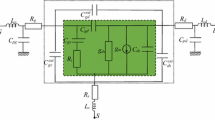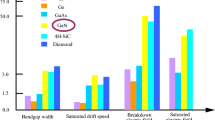Abstract
In this work, we utilize the Finite-Difference Time Domain (FDTD) Method coupled to a full-band, Cellular Monte Carlo (CMC) simulator to model the behavior of high-frequency devices. Replacing the quasi-static Poisson solver with a more exact electromagnetic (EM) solver provides a full-wave solution of Maxwell’s equations, resulting in a more accurate model for determining the high-frequency response of microwave transistors.
Similar content being viewed by others
References
Ayubi-Moak, J.S. et al.: Coupling Maxwell’s equations to full-band particle-based simulators. Journal of Computational Electronics 2, 183 (2003)
Branlard J. et al.: Frequency analysis of semiconductor devices using full-band Cellular Monte Carlo simulations. Monte Carlo Methods and Applications, Special Issue, (2004)
Bérenger, J.P.: Three-dimensional perfectly matched layer for the absorption of electromagnetic waves. J. Comput. Phys. 127, 363 (1996)
Sheen, D.M., Ali, S.M.: Application of the three-dimensional finite-difference time-domain method to the analysis of planar microstrip circuits. IEEE MTT 38(7), 849 (1990)
Liu, G., Gedney, S.D.: Perfectly matched layer media for an unconditionally stable three-dimensional ADI-FDTD method. IEEE Microwave Guided Wave. Lett. 9, 441 (1999)
Saraniti, M., Goodnick, S.M.: Hybrid full-band cellular automaton/Monte Carlo approach for fast simulation of charge transport in semiconductors. IEEE Trans. Elect. Dev. 47(10), 1909 (2000)
Kometer, K. et al.: Lattice-gas cellular-automaton method for semiclassical transport in semiconductors. Phys. Rev. B 46(3), 1382 (1992)
Yee, K.S.: Numerical solution of initial boundary value problem involving Maxwell’s equations in isotropic media. IEEE Trans. Antennas and Propagat. 14, 302 (1966)
Courant, R. et al.: On the partial difference equations of mathematical physics. IBM Journal, 215 (1967)
Namiki, T.: A new FDTD algorithm based on alternating-direction implicit method. IEEE MTT 47(10), 2003 (1999)
Zheng, F. et al.: A finite-difference time-domain method without the courant stability conditions. IEEE Microwave Guided Wave Lett. 9(11), 441 (1999)
Author information
Authors and Affiliations
Corresponding author
Rights and permissions
About this article
Cite this article
Ayubi-Moak, J.S., Goodnick, S.M. & Saraniti, M. Global Modeling of high frequency devices. J Comput Electron 5, 415–418 (2006). https://doi.org/10.1007/s10825-006-0028-3
Published:
Issue Date:
DOI: https://doi.org/10.1007/s10825-006-0028-3




